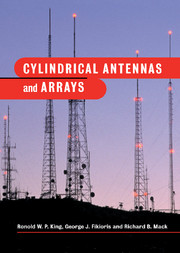Book contents
- Frontmatter
- Contents
- Preface
- Preface to first edition
- 1 Introduction
- 2 An approximate analysis of the cylindrical antenna
- 3 The two-element array
- 4 The circular array
- 5 The circuit and radiating properties of curtain arrays
- 6 Arrays with unequal elements: parasitic and log-periodic antennas
- 7 Planar and three-dimensional arrays
- 8 Vertical dipoles on and over the earth or sea
- 9 Dipoles parallel to the plane boundaries of layered regions; horizontal dipole over, on, and in the earth or sea
- 10 Application of the two-term theory to general arrays of parallel non-staggered elements
- 11 Resonances in large circular arrays of perfectly conducting dipoles
- 12 Resonances in large circular arrays of highly conducting dipoles
- 13 Direct numerical methods: a detailed discussion
- 14 Techniques and theory of measurements
- Appendix I Tables of Ψd R, T(m) or T′(m) and self-and mutual admittances for single elements and circular arrays
- Appendix II Tables of matrix elements Φu and Φυ for curtain arrays
- Appendix III Tables of admittance and impedance for curtain arrays
- References
- List of symbols
- Index
Preface to first edition
Published online by Cambridge University Press: 07 August 2009
- Frontmatter
- Contents
- Preface
- Preface to first edition
- 1 Introduction
- 2 An approximate analysis of the cylindrical antenna
- 3 The two-element array
- 4 The circular array
- 5 The circuit and radiating properties of curtain arrays
- 6 Arrays with unequal elements: parasitic and log-periodic antennas
- 7 Planar and three-dimensional arrays
- 8 Vertical dipoles on and over the earth or sea
- 9 Dipoles parallel to the plane boundaries of layered regions; horizontal dipole over, on, and in the earth or sea
- 10 Application of the two-term theory to general arrays of parallel non-staggered elements
- 11 Resonances in large circular arrays of perfectly conducting dipoles
- 12 Resonances in large circular arrays of highly conducting dipoles
- 13 Direct numerical methods: a detailed discussion
- 14 Techniques and theory of measurements
- Appendix I Tables of Ψd R, T(m) or T′(m) and self-and mutual admittances for single elements and circular arrays
- Appendix II Tables of matrix elements Φu and Φυ for curtain arrays
- Appendix III Tables of admittance and impedance for curtain arrays
- References
- List of symbols
- Index
Summary
Studies of coupled antennas in arrays may be separated into two groups: those which postulate a single convenient distribution of current along all structurally identical elements regardless of their relative locations in the array and those which seek to determine the actual currents in the several elements. Virtually all of the early and most of the more recent analyses are in the first group in which both field patterns and impedances have been obtained for elements with assumed currents. Pioneer work in the determination of field patterns of arrays of elements with sinusoidally distributed currents was carried out for uniform arrays by Bontsch-Bruewitsch [1] in 1926, by Southworth [2] in 1930, by Sterba [3] and by Carter et al. [4] in 1931. Early studies of non-uniform arrays are by Schelkunoff [5] in 1943, by Dolph [6] in 1946, and by Taylor and Whinnery [7] in 1951. The self- and mutual impedances of arrays of elements with sinusoidally distributed currents were studied especially by Carter [8] in 1932, by Brown [9] in 1937, by Walkinshaw [10] in 1946, by Cox [11] in 1947, by Barzilai [12] in 1948, and by Starnecki and Fitch [13] in 1948. A thorough presentation of the basic theory of antennas with sinusoidal currents was given by Brüuckmann [14] in 1939.
Information
- Type
- Chapter
- Information
- Cylindrical Antennas and Arrays , pp. xvii - xxPublisher: Cambridge University PressPrint publication year: 2002
